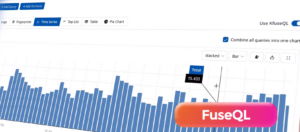
Kloudfuse Revs Its Observability Data Lake

(Yurchanka Siarhei/Shutterstock)
Organizations who are looking for a better way to manage and analyze their observability data may be interested in the latest update from Kloudfuse, which added several new data types and analytic/AI capabilities to its cloud data lake platform.
Observability data–all the logs, metrics, and traces generated by applications–is piling up at an alarming rate. Whereas a petabyte used to be considered a large amount of observability data, some organizations are now reporting that they have hundreds of petabytes, or even close to an exabyte.
Organizations are afraid to get rid of this data because it does have value, and in some cases, organizations are required by law to retain it for a certain period. But managing these massive data sets, and using it to track down IT issues, is becoming increasingly difficult in the exabyte age.
One of the vendors charting a new way forward with observability data is Kloudfuse. The Silicon Valley company came out of stealth one year ago with a data lake platform that fuses the affordable scalability of object storage with the latest analytics and AI techniques.
With today’s launch of Kloudfuse 3.0, the company is bolstering its offering in several ways. For starters, it’s added two new data streams that will give engineers insight into how or why things are going wrong, including real user monitoring (RUM), or monitoring of actual user sessions, and continuous code profiling, which helps to optimize code.
This release also brings several new analytics and AI capabilities, such as support for rolling quantile, SARIMA, DBSCAN, seasonal decomposition, and Pearson correlation coefficients. It also added support for open query languages like PromQL, LogQL, TraceQL, GraphQL, and SQL, the company says.
On the AI front, it’s supporting Prophet, an open source library of time-series anomaly detection algorithms developed by Meta. Kloudfuse 3.0 also is offering K-Lens, which will help customers detects outliers in large amounts of high-cardinality data.
This release also introduces FuseQL, a new log query language from Kloudfuse. The company says FuseQL provides functionality that’s missing from other log query languages, like LogQL, in the areas of anomaly and outlier detection. Another new feature is facet analytics, which uses the company’s patent-pending LogFingerprinting technology to automatically extract key attributes from logs for faster analysis and troubleshooting.
The 3.0 launch brings other capabilities, such as new JSON-based log archival capability that reduces storage costs and allows customers to “hydrate” the data when needed. New cardinality analysis and metrics roll-ups, meanwhile, provide greater insight into the shape and detail of the logs, metrics, and traces.
The company also announced support for Arm-based processors, including AWS Graviton and GCP’s Arm-based virtual machines. Customers can run Kloudfuse on their virtual private cloud (VPC) environments, including on AWS, Google Cloud, and Microsoft Azure.
Kloudfuse launched out of stealth in November 2023 with a $23 million funding round. The company was co-founded by CEO Krishna Yadappanavar, who previously founded hyperconvergence software provider Springpath, which Cisco bought for $320 million in 2017, as well as Ashish Hanwadikar from Springpath and Pankaj Thakkar, who previously was an engineer at VMware.
Yadappanavar says Kloudfuse 3.0 sets a new standard in unified observability.
“Customers can now gain deeper insights into their digital experiences and optimize performance in real time,” Yadappanavar said in a press release. “Our advanced features–including Digital Experience Monitoring, Continuous Profiling, powerful AI/ML capabilities, advanced analytics and visualizations, and a new query language–enable developers to identify and address performance bottlenecks with unprecedented efficiency. We’re proud to offer our clients the enterprise capabilities they need to create large-scale observability for their modern tech stack and drive their business forward.”
The company counts Workday, GE HealthCare and Automation Anywhere, among others, as paying customers.
Related Items:
Explosion of Observability Data from Cloud Reaches Tipping Point, Dynatrace Says
Data Observability in the Age of AI: A Guide for Data Engineers
GenAI Doesn’t Need Bigger LLMs. It Needs Better Data




























